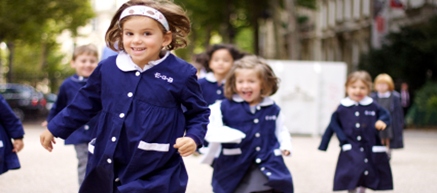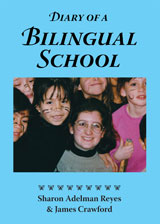In “Fostering Bilingual Education through Two-Way Immersion,” we describe how a constructivist curriculum and a multicultural approach to dual immersion led to the success of a two-way Spanish immersion program. The following narratives offer vivid evidence of why this is so. They illustrate, over the course of a school year, how bilingual instruction was blended with constructivist pedagogy adapted to the needs of second-language learners and how this combination was not only natural but necessary. Rather than isolated vignettes, these are interconnected stories that demonstrate the potential of the best dual immersion schools. They unfold in a second-grade classroom inhabited by teacher Jill Sontag, her eighteen bilingual collaborators, and an unending supply of insects—bugs that crawl, fly, mate, lay eggs, hatch and die—to the fascination of their human caregivers.
Diary of a Bilingual School
As the day began, the sounds of English and Spanish swirled and overlapped. Veronica and Alicia lingered in the Reading Corner, where Tupperware bins overflowed with books in both languages. Enrique and César shared a package of Oreos at the Resultados table, while Naomi read them a poem she had written. Other children were coming and going from a small storage area, the “saloncito,” as Ms. Sontag handed out paints and poster board. Like other teachers at Inter-American, she was constantly looking for ways to engage her students by encouraging their creative interests.
It was only October, but children’s artwork already covered the available wall space, colliding with dinosaur skeletons. Mobiles of geometric shapes, butterflies, and a large paper sun dangled from the ceiling, all crafted by second-grade hands. At the front of the room, a poster headlined “Acciones Valientes” bore the names of Camilo, Amber, and other children who had performed kind and heroic deeds on the playground or elsewhere. Hanging nearby were rosters listing the four cooperative learning groups: Procedimiento, Pregunta, Resultados, and Hipótesis. Procedure, Question, Results, and Hypothesis.
Bilingual lists of synonyms completely filled the rear chalkboard. The words to Gloria Estefan’s “Hablemos el Mismo Idioma,” We Speak the Same Language, printed neatly in block letters, occupied a flip chart. Near the classroom door, a sign read, “If I were in charge of the world …” Posted below, second-grade compositions described a world free of dentists and vegetables and full of chocolate ice cream and people who succeed in life even though they forget to take baths. The teacher’s desk, which she never seemed to use, had been taken over by student science projects.
Student creations also spilled into the hallway, which was starting to look like a children’s museum, complete with dioramas of prehistoric times and prehistoric predators. A mural spread across an adjacent wall, covered with the imprints of children’s feet, illustrating how scientists answer questions about dinosaurs. Responses by each of the learning groups were strategically placed among the footprints.
“¿Cuál dinosaurio corre y cuál camina?” Which dinosaur runs and which walks? The Procedimientos had answered: “Los científicos saben que un dinosaurio corre porque hay más distancia entre las piernas del dinosaurio que cuando caminan.” Scientists know that a dinosaur runs because there is more distance between their legs than when they walk.
Meanwhile, in the main classroom, more art was in production. Student-made big books traveled back and forth between tables. Manny and Amber were painting a poster for the school-wide potluck dinner next week. Dylan worked on the bill of his cap, making designs with a magic marker.
This was the scene in Room 307 when a mysterious visitor arrived.
“Ugggggh!” Veronica shrieked, jumping up from her chair in the Reading Corner. “Lookit, lookit!” Backing away, she pointed at a small black creature making its way slowly across the rug.
Alicia, who had been rummaging casually through the book bins, was startled as well. Peering from behind Veronica’s shoulder, she echoed her friend’s sentiment. “Oh, yuck! Gross!”
Soon a cluster of classmates gathered, surrounding the slowly moving object.
“Disgusting!” pronounced Enrique.
“Now our whole room’s gonna get disgusting!” Liset wailed.
Amber remained calm. “It’s just a bug,” she said.
“Yeah, I bet it’s a beetle,” Manny declared.
“No, it’s not, it’s a water bug,” Andy corrected. “I saw one before at my aunt’s house, in the basement. They’re not poisonous.”
“¿Por qué habrá un insecto de agua acá, si no hay agua?” Beatríz was bewildered why there would be a water bug where there was no water. So was Liset. “Is there water leaking in here?” she asked.
From across the room Ms. Sontag observed the commotion and prayed that the intruder was not a cockroach. The dilapidated building should have been replaced many years ago. Cold air crept in through the crevices in the winter, and so did bugs in the fall. But the Board of Education’s promise of a new school site never seemed to materialize.
“Hey, I bet if I step on it, it will go cruuuuuunch!” Damion looked at Veronica out of the corner of his eye. But before he could act on his idea, Ms. Sontag arrived.
“Niños, déjenlo en paz,” she said. Leave it in peace, kids. “Este pobre insecto no ha hecho nada malo a ninguno de ustedes. No es justo.” This poor insect hasn’t done you any harm. “Además es la hora de almorzar. Vámonos.” Besides, it’s time for lunch. Let’s go.
Her students slowly trickled toward the door, still wondering what kind of insect the ugly blob could be. And Ms. Sontag, always ready to experiment with curriculum, wondered what she might do with the sudden explosion of interest that had just occurred in her classroom.
Setting the Stage for Discovery
As a practitioner of what she calls “student-centered approaches”—her term for constructivism—Ms. Sontag has consciously designed Room 307 with such principles in mind. The physical environment itself facilitates learning, by stimulating children’s natural desire to explore and discover for themselves. Walls decorated with second-graders’ creations celebrate their talent and intellect, along with their emerging bilingualism.
The Reading Corner, where children can relax with books in English or Spanish, stresses the importance of literacy. The hallway display with student compositions on dinosaurs emphasizes problem-posing. How and why did scientists come to theorize what we know about dinosaurs? This approach is consistent with constructivist theory, which emphasizes concepts over facts, deep understanding over rote learning and the transfer of knowledge between disciplines.
Constructivists rely on teaching strategies that inspire further discovery. They believe that active learning is more likely to be internalized, retained and built upon. That is, it gives memory to what is worthwhile to know and experience.
This is an excerpt from the book Diary of a Bilingual School: How a Constructivist Curriculum, a Multicultural Perspective, and a Commitment to Dual Immersion Education Combined to Foster Fluent Bilingualism in Spanish- and English-Speaking Children, published by DiversityLearningK12 in January 2012.



































[…] Diary of a Bilingual Spanish School | InCultureParent […]
I’m reading this book at the moment and have to say I find it exceptionally interesting.
Although I taught Spanish to immigrant adults for some years and worked as well as a childhood educator while I was back in Spain, teaching in Spanish in a preschool setting with children whose mother tongue is not Spanish is something completely new to me. In our school, the Spanish programme follows the British curriculum as does the rest of the school, but we only speak Spanish. Many people think that simply because I’m a spanish native speaker my job is an easy task. I love my job, I love the children in my classroom, but this job is anything but simple. There are still so many wrong ideas going around bilingualism that it is hard to get people to listen to you when you say that learning two or three languages at a time is not only possible, but positive! Often times, these same people blame bilingualism for common mistakes many children do, such as misspelling a word or stuttering. It is even sadder and worrying when that kind of comments come from some of your own colleagues.
The good news is that there is an increasing number of studies available on bilingualism and people who care about it and try their best. The narratives in this book are tremendously encouraging and I would recommend it to any teacher that, like me, feels at times a bit lonely in the amazing journey of working with bilingual children!